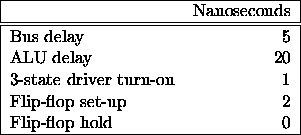- Assume that a memory operation takes the same amount of time as
one internal CPU step. Rewrite the control sequence.
- Assume that a memory operation takes the same amount of time as
two internal CPU steps. Rewrite the control sequence.

What is the minimum time that must be allowed for performing each of the following operations?
- Transfer data from one register to another.
- Increment the program counter.
Next, consider the Add instruction that has the control sequence given in Figure 3.5. The CPU is driven by a continuously running clock signal, such that each control step is 20 ns. in duration. How long will the CPU have to wait in steps 2 and 5, assuming that a memory read operation takes 80 ns. to complete? What percentage of the time is the CPU idle during execution of this instruction?
- Add the immediate value NUM to register R1.
- Add the contents of memory location NUM (direct addressing) to
register R1.
- Add the immediate value NUM to register R1 (indexed addressing);
fetch the memory location whose address is that sum and add it to
register R2.
Write the sequence of control steps for:
- The bus structure in Figure 3.1.
- The bus structure in Figure 3.13.
- Add (R3), R1, Figure 3.5.
- The branch-on-negative instruction discussed in Section 3.2.1.